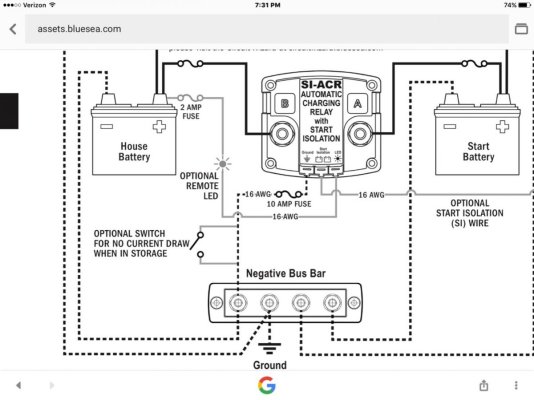Just helped a dock mate replace a group 31 starting battery on his new (to him) trawler. The house bank is a relatively new set of 4 trojan 6V's. The failed battery was installed in 2013. The new one tested out with a full charge at the store.
Keep in mind that most G-31 starting batteries are an inexpensive automotive grade battery with a "marine"
sticker. The plates are thin, separators thin, very little room for shed sulfate to build up before an internal short occurs and the grids are very thin. They don't handle the vibration abuse a golf cart battery can. On some power boats & go fast flat bottomed racing sailboats, these starting batteries can suffer short lives due to plates cracking/fracturing with chunks of plate dropping to the bottom of the case & creating an internal short.. Starting batteries are also far too often installed in engine bays where temps can hoover far above where the battery would deliver a suitable life. Heck no battery should be installed in an engine bay, but boat builders could really care less about battery cycle life after it leaves their factory. If one must buy a G-31 flooded battery, even for starting, it is best to stick with the "deep cycle" version as they are slightly more ruggedly built. Course this is no guarantee and a G-24, 27 or 31 flooded battery is really not a "deep cycle" battery when compared to a golf cart battery. In my experience Crown, Trojan and US Battery all build a decent G-24, 27 or 31 "deep cycle" battery.
Also any battery manufacturer can have a bad one in the lot. The replaced G-31 could have just been the bad apple.
The two banks are on a Blue Sea combiner. The green "combined" light is on whenever the Heart inverter/charger is powered, or the alternator is running (single engine, Balmar 150A, externally regulated.)
This is how a voltage sensing relay should work. It is really nothing more than an automated BOTH/PARALLEL device that either parallels or un-parallels the banks based on voltage levels.
Parallels @ 13.6V after 30 Seconds
Parallels @ 13.0V after 90 Seconds
Un-Parallels @ 12.35V after 10 Seconds
Un-Parallels @ 12.75V after 30 Seconds
It's now 6-7 hours after the install. The inverter is still showing "charging" at 13.8V, although the current is less than 1 amp to either bank. It never went to "accept" or "float."
If that 13.8V is being held steady it is likely already in float. Float may also be being temp compensated
up if the batteries are cool. That said if float is set for 13.8V, and there is no temp sensor, float is a bit high for the Trojan's, if this boat is dockside most of the time. Trojan wants to see 14.8V for absorption and 13.5V for float both of these temp compensated. Most older Heart I/C's only had dip switches for cool, warm etc. not a real temp sensor. If the unit is connected to a LINK remote then charge set points should be adjusted to suit the Trojan's.
As I understand it, the combiner connects the two banks whenever there's charging current, and disconnects them otherwise.
Not on
current, the ACR combines based on
system voltage. As long as the batteries remain above 12.75V, and don't drop below that for more than 30 seconds, the batteries will be in parallel. 12.75V is right at the 100% SOC range for most lead acid batteries so you're not "discharging" in parallel just charging.
Is this a good thing? I was under the impression that two banks with different battery configurations shouldn't be charged together. Then again, with just a single engine, how else would you make sure both were charged while underway?
Most 12V flooded batteries can be charged in parallel without any issue. The thing that matters is the recommended charging voltages. With system voltage at XX.XX the batteries on the charge bus will simply take the current that need at XX.XX volts and XX SOC. Heck even when an AGM and flooded batteries share the same charging profile there is really no big deal in charging using a voltage sensing relay.
The real problem in the industry are crappy so called "smart" chargers that do not allow users to properly configure them for manufacturer recommended charging voltages, lack temp compensation, used simple "egg timer" algorithms and do not allow absorption times to be modified.
One of the biggest issues surrounding VSR/ACR/Combiners is an incorrect installation for the application, which leads to relay cycling.
Any time you have a large deep cycle bank and a small start battery all charge sources (wind, solar, alternator, battery charger etc.) should feed directly to the house bank not the start battery. The prevents relay-cycling (the in-built delays do not always prevent this) and ensures the VSR/ACR/Combiner is passing the least amount of current across it at all times, a best practice.



